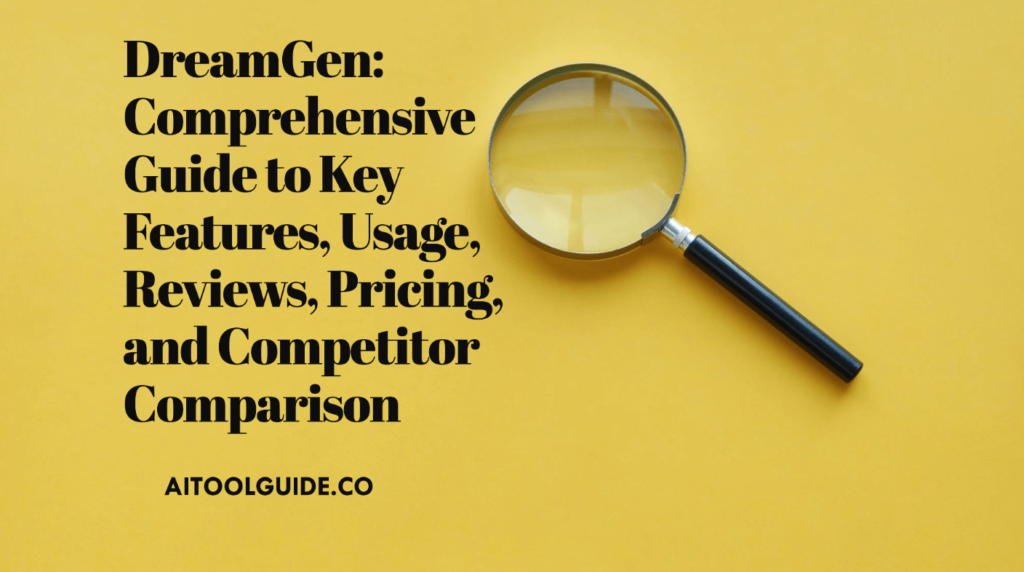DreamGen is an innovative AI-powered platform designed for immersive role-play and story-writing experiences.
Unlike traditional storytelling tools, DreamGen offers users unrestricted creative freedom, allowing them to explore fantasy realms and craft unique scenarios without limitations.
The platform features intuitive scenario editors, extensive world-building capabilities, and the ability to create and interact with multiple characters.
DreamGen’s AI models, including V0 and V1, provide users with various options for generating content, while its context window sizes range from 4000 to 12000 tokens, depending on the subscription plan.
With pricing options starting from $7.83 per month, DreamGen caters to both casual users and professional writers.
The platform’s credit system allows for flexible usage of AI features, including image generation. DreamGen stands out among AI role-play alternatives for its commitment to open-source models and its focus on providing a seamless, customizable experience for users seeking to unleash their creativity in storytelling and role-playing.
KeyTake Aways
Immersive Role-Play Platform: AI-driven storytelling tool.
Customizable Scenarios: Extensive world-building options.
Multi-Character Interaction: Engage with multiple characters.
Flexible AI Models: Varying context window sizes.
Affordable Pricing: Plans start at $7.83/month.
Open-Source Models: Constantly improving AI capabilities.
Creative Freedom: Unrestricted storytelling possibilities.
Collaborative Storytelling: Work with other writers.
User-Friendly Interface: Intuitive and easy to navigate.
Professional Writing Support: Suitable for novel drafting
General Overview of DreamGen
DreamGen is a cool AI tool that lets you write stories and play pretend with computer characters. It’s like having an imaginary friend who can tell you stories or play make-believe with you.
The way it works is pretty neat – you start by picking a story setting, like a magical forest or a space station.
Then you can make up your own characters or use ones that are already there. Once you’re ready, you just type what you want to happen next, and the AI (that’s the smart computer part) figures out how the story should go.DreamGen has some awesome features for role-playing and storywriting.
You can talk to multiple characters at once, which is super fun for making big adventures. There’s also a scenario editor where you can build your own worlds with lots of details.
The AI is really good at following your lead, so if you want the story to take a crazy turn, it’ll go along with it. You can even tell the characters how to act or what to say next.
The AI models that power DreamGen are pretty special. They use something called open-source models, which means they’re always getting better because lots of smart people work on them.
These models are really good at understanding what you’re trying to do with your story and coming up with creative ideas.
They can remember important stuff that happened earlier in the story, so everything makes sense. The AI can also help with things like describing scenes or coming up with names for people and places.DreamGen has two main AI models called V0 and V1.
The V0 model is like the basic version – it’s still really good at making stories, but it might not remember as much or be as creative. The V1 model is a fancy upgrade.
It can remember way more of your story (up to 12,000 words!), which means your adventures can be super long and detailed. The V1 model is also better at understanding what you want and coming up with more interesting ideas.
It’s like having a super smart storytelling buddy who never runs out of ideas.Both models are great for different things.
If you’re just starting out or want to write shorter stories, the V0 model might be perfect. But if you’re working on a big, complicated story with lots of characters and twists, the V1 model could be your best friend.
No matter which one you pick, DreamGen makes it easy to let your imagination run wild and create amazing stories that you never thought possible. It’s like having a whole world of adventures right at your fingertips!
Getting Started with DreamGen
To get started, visit the DreamGen website (dreamgen.com) and click on “Create an account” or “Sign up with email”. You’ll need to provide an email address and accept the privacy policy and terms of service.
Alternatively, you can sign up using your Google account. Once registered, you can log in to your account using your email and password or through Google authentication.
DreamGen provides a free tier with limited credits that reset monthly, allowing users to try out the platform before considering a paid subscription for unlimited access to their high-quality text generation models.
DreamGen’s user interface and chat-like experience
DreamGen’s user interface is super sleek and feels just like chatting with a friend. When you log in, you’ll see a clean screen with a big text box at the bottom. That’s where you’ll type your part of the story. Above that, you’ll see the ongoing conversation with your AI characters.
It’s easy to follow along, and you can even change the colors or add a cool background picture to make it feel more like your own special world. The chat-like setup makes it feel natural to interact with your characters and keep the story flowing.
DreamGen’s character creation and customization options
Creating characters in DreamGen is where you can let your imagination go wild. You can make anyone you can dream up! Want to be a space pirate with purple skin? Go for it! Or maybe a talking cat who’s really good at solving mysteries? You got it!
The character creator lets you choose how your character looks, what they like and don’t like, and even give them a backstory.
You can set their personality traits, decide how they talk, and even pick their favorite foods. The more details you add, the more real your character will feel when you start playing.
How to create custom scenarios in DreamGen?
Making your own scenarios in DreamGen is where things get really exciting. A scenario is like the setting and basic plot for your story. You might start with something simple like “A day at the beach” or go wild with “Trapped on a planet made of candy.”
The cool thing is, you can make your scenario as detailed as you want. You could describe the smell of the ocean or the sticky feeling of walking on gummy bear sand.
When creating a scenario, think about the setting, the main characters, and what kind of adventure or problem might happen. The more you put in, the more the AI has to work with, making your stories richer and more interesting.
How to Use DreamGen’s Scenario Editor effectively?
To make your scenarios even better, you’ll want to use the scenario editor like a pro. Here’s a neat trick: start by writing a short intro that sets the scene. Then, add some key details about the world or situation.
For example, if your story is set in a magical school, you might mention the floating candles in the dining hall or the secret passages behind the paintings. Don’t forget to add some hints about possible adventures or challenges.
Maybe there’s a forbidden forest nearby or a mysterious locked door in the basement. The scenario editor also lets you set up character relationships, plot twists, and even alternate endings. The more you put into your scenario, the more amazing and unpredictable your stories can be!
Remember, the key to having a blast with DreamGen is to let your imagination run wild. Don’t be afraid to try crazy ideas or take your story in unexpected directions. The AI is really good at rolling with whatever you throw at it.
And if you ever get stuck, you can always use the autopilot feature to let the AI take over for a bit and suggest what happens next. With DreamGen, you’re the boss of your own stories, so have fun and see where your creativity takes you!
Advanced Features and Storytelling of DreamGen
DreamGen’s AI story writer functionality
DreamGen’s AI story writer is like having a super smart writing buddy. It helps you create amazing stories without breaking a sweat. You can start with a simple idea, like “a wizard finds a talking book,” and the AI will run with it.
It adds cool details and exciting twists to your story. The best part? You’re still the boss. If you don’t like where the story is going, you can tell the AI to change things up.
How to steer narratives and control plot development in DreamGen?
Guiding your story in DreamGen is a piece of cake. You can tell the AI exactly what you want to happen next. For example, if you’re writing about a space adventure, you might type, “Suddenly, a giant alien ship appears!”
The AI will take that idea and describe what happens next. You can also tell characters how to act or what to say. It’s like being the director of your own movie – you’re in charge, and the AI brings your ideas to life.
DreamGen’s context window sizes and their impact on storytelling
The context window in DreamGen is like the AI’s memory. It decides how much of your story the AI can remember when coming up with new ideas.DreamGenoffers different window sizes, from 4000 to 12000 tokens.
A bigger window means the AI can remember more of your story, which is great for long, complex tales. With a smaller window, the AI might forget some earlier details, but it can be faster and work well for shorter stories.
How to fine-tune AI model settings in DreamGen?
DreamGen lets you adjust the AI settings to make your stories just right. You can change how creative or random the AI gets. If you want wild, unexpected twists, you might turn up the randomness. If you want a more focused story, you can turn it down.
You can also control how much the AI repeats itself or how closely it sticks to your writing style. It’s like having a bunch of knobs to adjust your storytelling machine.
Multi-character support in DreamGen role-plays
One of the coolest things about DreamGen is that you can play with lots of characters at once. You could be talking to a brave knight, a wise dragon, and a mischievous fairy all at the same time. This makes your stories feel more real and gives you tons of options for how things could go.
You can even create different personas(that’s like having different versions of yourself) to use in your role-plays. This feature lets you explore all sorts of fun scenarios and interactions between characters. With these awesome features, DreamGen helps you create all kinds of amazing stories.
Whether you’re writing a quick, fun tale or a long, exciting adventure, the AI is there to help bring your ideas to life. And remember, there are no rules – you can let your imagination go wild and see where your story takes you!
Stunning Creative Applications of DreamGen
To make your role-play super fun in DreamGen, try these cool tricks. First, really get into your character’s head. Think about how they talk, what they like, and how they’d react to things.
Use lots of details when you describe stuff. Instead of just saying “The room was big,” you could say “The room was huge, with sparkly chandeliers and squishy red carpets.”
This makes the world feel more real. Also, don’t be afraid to throw in surprises. Maybe your wizard suddenly discovers they can talk to cats!
Using DreamGen for fantasy world-building and lore creation
DreamGenis awesome for making up whole new worlds. You can create magical realms, alien planets, or even underwater kingdoms. Start by thinking up some big ideas for your world. What kind of magic exists? Are there different races or creatures?
Then, use the AI to help fill in the details. You could ask it to come up with cool names for places or to describe what the food is like in your world. The more you add, the more real your world will feel.
DreamGen’s approach to unrestricted creative freedom
One of the best things aboutDreamGenis that it lets your imagination run wild. There are no rules about what you can or can’t write. Want to make a story where gravity works backward?
Go for it! TheAIwill play along with whatever crazy ideas you have. This means you can explore all sorts of fun and wacky scenarios without anyone telling you “That’s not possible.”
NSFW content and restrictions in DreamGen
DreamGenis pretty open when it comes to what you can write. It doesn’t have strict filters or censorship. This means you can write about more grown-up topics if you want to.
But remember, with great power comes great responsibility! It’s up to you to use this freedom wisely and respectfully. If you’re not sure if something is okay to write about, it’s always best to ask a grown-up first.
Using DreamGen for professional writing and novel drafting
DreamGen isn’t just for fun – you can use it to write serious stuff too! If you’re working on a book or a story, they help you come up with ideas or even write whole chapters. It’s like having a super smart writing buddy who never gets tired.
You can use it to brainstorm plot ideas, create detailed character backgrounds, or even help you get unstuck when you don’t know what to write next. Some writers have even used AI tools like this to help them write whole books!
DreamGen Pricing and Features
DreamGen offers a range of pricing plans to fit different needs and budgets. The Starter plan is $7.83 per month, giving you access to all models and a 4000 token context window. If you need more power, the Advanced plan at $19.35 per month ups your context window to 8000 tokens.
For the serious storytellers, the Pro plan at $48.30 per month offers a whopping 12000 token context window. All plans use a credit system, where you spend credits to generate text or images.
The free tier gives you 50 credits a month, while paid plans offer more. For example, the Starter plan gives you 375 monthly credits plus 45 extra daily credits.
Image generation is also available, with costs varying based on quality and quantity. The free tier lets you try out all the features, making it easy to see if DreamGen is right for you.
Paid plans offer perks like bigger context windows, more credits, and discounts on credit packs. Whether you’re a casual writer or a pro, DreamGen has a plan that’ll help your stories come to life!
Technical Aspects and Integration
DreamGen offers cool tech features that make it super easy to use and customize. Let’s check ’em out! First up, DreamGen’s API is like a secret passageway that lets you connect it to other apps.
You can use it with popular platforms like SillyTavern or Kobold. This means you can use DreamGen’s awesome AI writing powers in your favorite story-making apps. It’s like giving your favorite toy a super boost!
The open-source AI models that DreamGen uses are pretty special. They’re like recipe books that anyone can look at and improve.
This means the AI gets smarter all the time because lots of smart people are working on it. It’s like having a bunch of genius friends helping you write your stories! If you love using your phone or tablet to write, you’re in luck!
DreamGen works great on these devices. You can spin up stories while you’re on the bus or chilling in the park. It’s like having a pocket-sized writing buddy that goes everywhere with you. Lastly, there’s the super cool autopilot mode.
It’s like letting the AI take the wheel for a bit. You can sit back and watch as the story unfolds by itself. It’s perfect for when you’re stuck or just want to see where the story might go. Imagine having a magical pen that writes stories for you – that’s what autopilot mode is like!
Comparison of DreamGen with other AI role-play platforms
DreamGen stands out among AI role-play platforms for its unique features and approach. Let’s compare it to some popular alternatives:
Character AI is a well-known platform, but DreamGen offers more creative freedom. While Character AI has a rating of 3.2 based on 25 ratings, DreamGen scores higher with a 4.1 rating from 8 users.
DreamGen’s open-source models and lack of censorship allow for more unrestricted storytelling. Unlike Replika, which focuses on being an AI companion, DreamGen is geared towards interactive storytelling and creative writing. Replika aims for emotional engagement, while DreamGen excels in crafting complex narratives and worlds.
AI Dungeon is similar to DreamGen in its focus on interactive storytelling. However, DreamGen offers more advanced customization options for AI settings and character creation.
DreamGen’s open-source models also provide more transparency and potential for improvement. Janitor AI is another platform for creating and interacting with AI characters.
While it offers customizable characters, DreamGen goes further by providing a story-writing mode that enables collaboration with multiple AI characters.
Inworld Arcade, like DreamGen, allows users to create and interact with AI characters. However, DreamGen offers more advanced features for story steering and plot development. Compared to these alternatives, DreamGen stands out for its:
Unrestricted creative freedom within a professional framework
Advanced scenario crafting for serious writers
Open-source models available on HuggingFace
API access for developers
Affordable pricing with a free tier
While DreamGen may have a more limited library of built-in scenarios compared to some competitors, its powerful customization options and focus on serious writing make it a top choice for creative storytellers and role-players.
How to publish and share scenarios on DreamGen?
DreamGen makes it a breeze to share your creative worlds with others. Once you’ve crafted your awesome scenario, you can hit the“Publish” button to make it public.
This lets other DreamGen users discover and play your creation. You can also grab a special link to your scenario and share it directly with friends or on social media.
It’s like showing off your cool LEGO creation but with stories!If you want to keep your scenario just for you and your buddies, you can use the“Share” feature instead.
This gives you a secret link that only works for people you choose to share it with. It’s perfect for when you’re working on a group story or want to surprise someone with a personalized adventure.
DreamGen’s community features and collaborative storytelling options
DreamGen isn’t just about solo storytelling – it’s got some neat ways to team up with other writers too! The“Collaborative Mode” lets you and your friends work on the same story together. It’s like a digital campfire where everyone can add to the tale.
There’s also a cool“Community Hub” where you can check out popular scenarios, get inspiration, and chat with other DreamGen users.
It’s a bit like a writer’s club, but online and open 24/7. You can even leave comments and ratings on scenarios you’ve played, helping others find the good stuff.
For those who love a challenge, DreamGen sometimes runs writing contests where you can show off your skills and maybe win some prizes. It’s a fun way to push your creativity and see what other writers are cooking up.
DreamGen’s future development plans and upcoming features
The folks behind DreamGen are always cooking up new ideas to make the platform even cooler. They’ve got a roadmap that shows what’s coming next, and it’s pretty exciting stuff!One big thing they’re working on is making the AI models even smarter.
They want to bump up the token limit, which is a fancy way of saying the AI will be able to remember more of your story as you write. This means you’ll be able to create even longer, more complex adventures without the AI forgetting important details.
They’re also planning to add image generation to the mix. Soon, you might be able to describe a character or scene in words, and the AI will whip up a picture to match.
It’ll be like having an artist right there with you as you write! DreamGenis also aims to add more pre-made scenarios to their library, giving you even more jumping-off points for your stories.
And they’re always tweaking the user interface to make it easier and more fun to use. With all these cool updates in the works, DreamGen is shaping up to be an even more awesome playground for your imagination!
Frequently Asked Questions
Q: Is DreamGen suitable for beginners in creative writing?
A: Yes, DreamGen is user-friendly for beginners. Its intuitive interface and AI assistance make it easy to start creating stories, even if you’re new to writing.
Q: Can I use DreamGen for educational purposes?
A: Absolutely! DreamGen can be a great tool for teaching creative writing, storytelling, or even language learning. It’s adaptable for various educational settings.
Q: Does DreamGen support languages other than English?
A: While primarily designed for English, DreamGen can work with other languages. However, the quality of output may vary depending on the language used.
Q: Can I import my existing stories into DreamGen?
A: Yes, DreamGen allows you to import existing text. This feature is great for continuing or expanding on stories you’ve already started elsewhere.
Q: Is there a word limit for stories created in DreamGen?
A: There’s no strict word limit for stories. However, the context window size (which varies by subscription tier) affects how much of your story the AI can consider at once.
Q: Can DreamGen help with writer’s block?
A: Definitely! DreamGen’s AI can suggest plot twists, character actions, or descriptions when you’re stuck, helping to overcome writer’s block.
Q: Is it possible to collaborate with other human writers on DreamGen?
A: Yes, DreamGen offers collaborative features that allow multiple human writers to work on the same story together, alongside the AI.
Q: Can I use characters from existing works in my DreamGen stories?
A: While you can create characters inspired by existing works, it’s important to respect copyright laws. DreamGen encourages original character creation.
Q: Does DreamGen offer any tools for organizing complex storylines or character relationships?
A: DreamGen provides features for managing characters and plot points. However, for very complex stories, you might want to use additional organizational tools.
Q: Can I publish or sell stories I create with DreamGen?
A: Yes, you retain the rights to the stories you create. However, it’s advisable to review and edit AI-generated content before publishing or selling it.
Conclusion
DreamGen stands out as a powerful and flexible tool for creative writers and role-players alike. With its open-source AI models, unrestricted creative freedom, and advanced features like scenario crafting and multi-character support, it offers a unique playground for imagination.
Whether you’re a casual storyteller or a serious novelist, DreamGen’s range of pricing plans and features can accommodate your needs.
While it may have fewer pre-made scenarios than some competitors, its customization options and focus on serious writing make it a top choice.
As DreamGen continues to evolve with exciting new features on the horizon, it’s poised to remain at the forefront of AI-assisted storytelling and role-play platforms.
- Guide to Connect Claude AI with Google Sheets in 2024 - October 11, 2024
- What is DreamGF? Honest review by Expert - October 9, 2024
- How to Use Claude AI in 2024? - October 7, 2024






